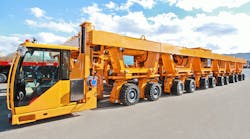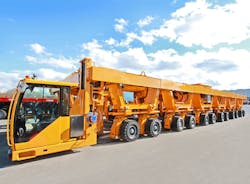Much of the equipment Kuebler moves is too large even for one of these vehicles, so two or more may be used in concert to move an entire oil platform, tunnel-boring machine, ship, or other structure. The SPMTs are driven, steered, and provide lifting via hydraulics. Depending on the application, a single hydraulic power unit may serve multiple vehicles. When an especially large load requires more than one transport unit, an SPMT containing the HPU can be connected to other vehicles using hydraulic couplings. A hydraulic motor powers drive wheels, and the SPMTs are raised and lowered by 14 hydraulic lifting forks linked to each axle. Each fork can lift 30 tonnes.
In this case, a 338-kW (453-hp) MAN diesel engine powers the HPU. Controlling and coordinating motion and direction of all these actuators is complicated, so a computer tied into the hydraulic systems coordinates steering and keeps motion and direction of individual SPMTs closely synchronized for precise positioning. In addition, a camera and radar system lets operators closely monitor vehicle movement for safety and efficiency.


